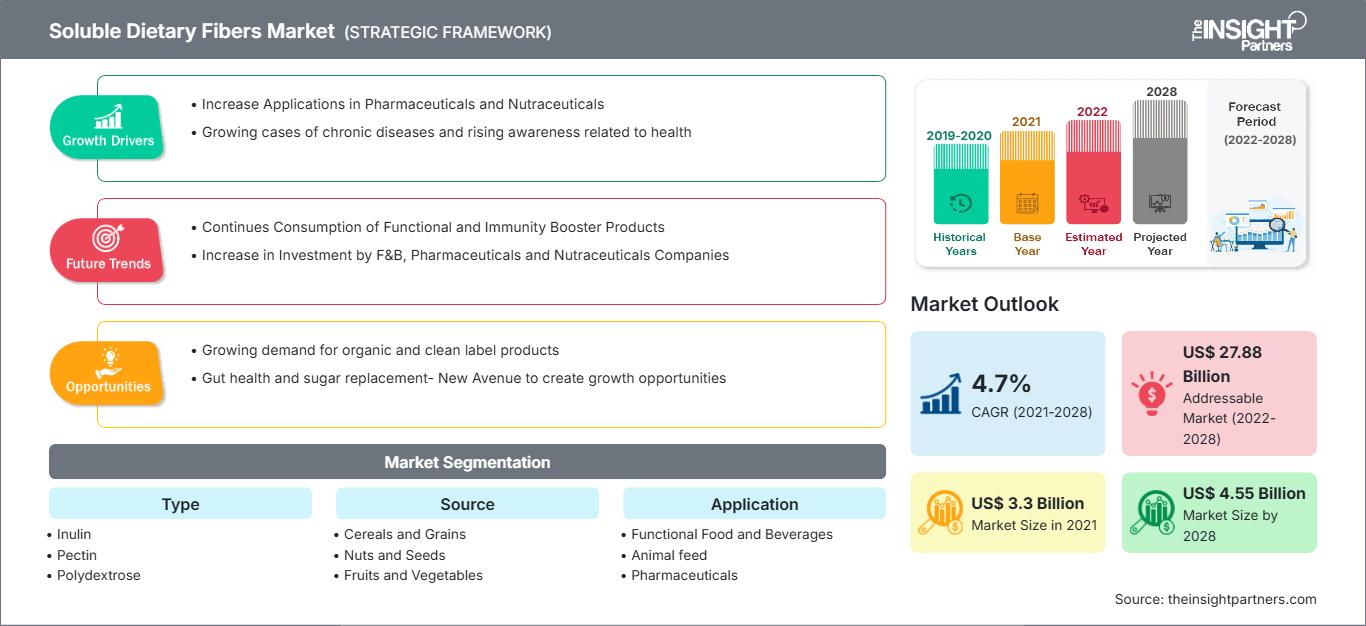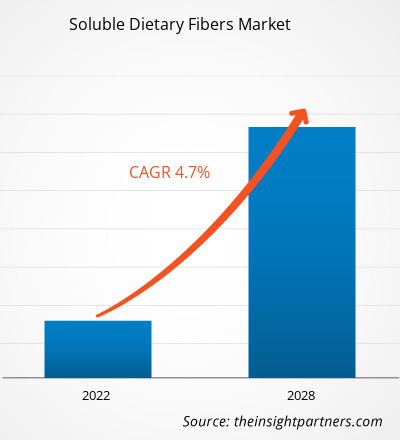水溶性食物繊維市場は、2021年の33億131万米ドルから2028年には45億4647万米ドルに拡大すると予想されており、2021年から2028年にかけて年平均成長率(CAGR)4.7%で成長すると推定されています。
水溶性食物繊維は、水に分散してゲル状物質を形成する繊維と定義されます。これらの繊維は、消化管で粘性のゲルを生成し、胃から腸への食物の通過を遅らせる機能を持っています。このようなタイプの繊維は、果物、野菜、豆類、オート麦から多く得られます。水溶性食物繊維は、腸内のビフィズス菌や乳酸菌の刺激、冠動脈の健康を促進し、コレステロールや血糖値を下げるなど、結腸の健康に役立ちます。消費者のライフスタイルの変化と、機能性食品成分としての食物繊維の取り入れ増加により、水溶性食物繊維の需要が高まっています。さらに、食品・飲料、医薬品・栄養補助食品、動物飼料など、さまざまな業界での水溶性食物繊維の用途基盤の拡大が、今後数年間の市場成長の原動力になると予想されています。
2021年、アジア太平洋地域は世界の水溶性食物繊維市場で最大の収益シェアを占めました。アジア太平洋地域における水溶性食物繊維の消費量が多いのは、健康とウェルネスへの意識の高まりによるものです。製造拠点の存在と、食品・飲料加工業界からの水溶性食物繊維の需要増加が、この地域の市場成長を牽引しています。さらに、消費者のライフスタイルの変化と食品・飲料業界の活況、そして世界的な市場プレーヤーによる市場浸透が、今後数年間の市場成長を牽引すると予想されます。さらに、継続的な研究開発と、医薬品、栄養補助食品、動物飼料などの産業の成長により、地域市場で水溶性食物繊維が広く採用されるようになりました。
要件に合わせてレポートをカスタマイズ
レポートの一部、国レベルの分析、Excelデータパックなどを含め、スタートアップ&大学向けに特別オファーや割引もご利用いただけます(無償)
水溶性食物繊維市場: 戦略的洞察

-
このレポートの主要な市場動向を入手してください。この無料サンプルには、市場動向から見積もりや予測に至るまでのデータ分析が含まれます。
COVID-19パンデミックによる水溶性食物繊維市場への影響
現在も続くCOVID-19パンデミックは、食品・飲料業界の状況を劇的に変え、水溶性食物繊維市場の成長に悪影響を及ぼしています。ウイルスの蔓延を防ぐための対策の実施は状況を悪化させ、複数の産業セクターの成長に影響を与えています。市場は、国内外の国境の突然の閉鎖に起因する業務効率の急激な低下とバリューチェーンの混乱の影響を受けています。サプライヤーからの原材料調達の混乱、無期限のロックダウンや一時的な検疫による製造拠点の一時的な閉鎖は、パンデミック中の市場の成長に影響を与えました。しかし、パンデミックがサプライチェーンの運営に影響を与えたのと同じくらい、パンデミックは消費者の間で健康的な生活へのニーズを生み出し、その結果、消費者は栄養食品に目を向けるようになりました。例えば、Nutrition Insightが2020年6月に発表した記事によると、パンデミックは、オーガニック、ナチュラル、クリーンラベル製品への傾向の高まり、腸内環境の維持と砂糖代替への強い関心により、食物繊維市場に成長の機会をもたらしました。世界保健機関(WHO)の健康ガイドラインによると、微生物に対する免疫力を高めるには、1日25gの食物繊維を摂取することが不可欠です。オート麦、大麦、エンドウ豆、リンゴ、柑橘類、ジャガイモから得られる水溶性食物繊維、および化学的に加工された硫酸化グルカンは、便秘を緩和し、強力な抗ウイルス作用を示す可能性があります。さらに、国際プロバイオティクス・プレバイオティクス科学協会(ISAPP)によると、イヌリンとオリゴフルクトースは、現在のパンデミック時代に不可欠な腸内環境の健康を促進する能力を持つ、植物由来のプレバイオティクス水溶性食物繊維の重要なタイプに分類されています。例えば、FoodIngredientsFirstが発表した記事によると、消費者はオーガニックのチコリ根繊維の摂取に積極的に取り組んでいます。この繊維は水溶性イヌリンから構成されており、腸内環境、精神面の健康、そして免疫力の向上に役立ちます。そのため、機能性食品や免疫力向上製品の消費が拡大する中で、パンデミック後の時代には水溶性食物繊維の需要が急増すると予想されます。さらに、各国が経済活動の回復を目指していることから、世界的に水溶性食物繊維の需要が高まると予想されます。食品・飲料業界全体における水溶性食物繊維の需要拡大は、消費者の健康と安全にとって非常に重要です。飲料、医薬品、栄養補助食品、動物飼料、その他の産業における水溶性食物繊維の需要の増加と、有名メーカーによる多額の投資が相まって、水溶性食物繊維市場の拡大が見込まれています。
市場洞察
医薬品および栄養補助食品における水溶性食物繊維の用途拡大
水溶性食物繊維は食品添加物として使用され、腸内のビフィズス菌や乳酸菌の刺激、冠動脈の健康、コレステロール値の低下、グルコース代謝の促進など、結腸の健康を促進します。さらに、水溶性食物繊維は体重管理に貢献し、心血管疾患のリスクを軽減します。水溶性食物繊維は、食物繊維の重要な形態の1つと考えられています。イヌリン、ベータグルカン、ポリデキストロース、ペクチン、フラクトオリゴ糖、ガラクトオリゴ糖、コーンファイバーで構成されており、添加された食品や飲料製品の栄養価を高めるのに役立ちます。
例えば、ロケット社は、食品、医薬品、栄養補助食品業界向けに、「NUTRIOSE」というブランド名で非粘性の水溶性食物繊維を提供しています。NUTRIOSEは小麦やトウモロコシなどの穀物から作られ、効率的な消化耐性を提供します。同様に、高級スポーツ・ウェルネス栄養会社であるSteadfast Nutritionは、「Tri Fiber」というブランド名で水溶性食物繊維ベースの栄養補助食品パウダーを提供しています。水溶性食物繊維は、腸内環境の健康維持、血糖値と血清脂質のバランス維持に役立ちます。さらに、この製品は食欲ホルモンのコントロールを助け、排便を促進し、体内のトリグリセリド値を管理してコレステロール値を制御することで脂質プロファイルを改善します。難消化性マルトデキストリンの改善された効果は、特定保健用食品(FOSHU)によって特定されています。この製品は、オフィスワーカー、ウェイトウォッチャー、アスリート、フィットネス愛好家、患者が摂取できます。同様に、ベネファイバーとメタムシルは、市販の(OTC)水溶性食物繊維サプリメントです。ベネファイバーは、食物繊維サプリメントとして食品医薬品局(FDA)に承認されており、有効成分として小麦デキストリンで構成されています。腸管での水分の吸収を助け、蠕動運動、つまり腸の筋肉の反復的な収縮と弛緩を刺激します。メタムシルは、インドのハーブであるオオバコの種子から得られるオオバコの殻から作られています。健康への関心の高まり、水溶性食物繊維による健康効果への意識の高まり、慢性疾患の増加に伴い、メーカーは水溶性食物繊維をベースにした栄養補助食品や医薬品を生産するようになり、世界市場で水溶性食物繊維の需要が拡大すると予想されています。
タイプ別インサイト
タイプ別に、水溶性食物繊維市場は、イヌリン、ペクチン、ポリデキストロース、ベータグルカンなどに分類されています。2021年には、イヌリンセグメントが市場を席巻しています。イヌリンは多くの植物から得られる水溶性繊維です。小麦、玉ねぎ、ニンニク、バナナ、ネギ、アーティチョーク、チコリの根、アスパラガスなど、さまざまな種類の果物、野菜、ハーブからイヌリンが抽出されます。薬用としては、イヌリンは一般的にチコリの根から得られます。イヌリンは、減量、便秘、下痢、糖尿病に使用されます。また、治療薬の送達ツールとしても使用されています。イヌリンのサプリメントは、カプセルと粉末の形で入手できます。イヌリンは、乳製品、パン、シリアルバー、ヘルスケア栄養、新生児栄養、飲料、菓子、アイスクリーム、風味食品など、さまざまな製品に使用されています。多くの食品メーカーは、食品のプレバイオティクス含有量を高め、食品中の脂肪と糖を置き換え、腸の健康に有益なため食品の健康効果を高めるために、加工製品にイヌリンを添加しています。イヌリンは味と食感を改善します。高濃度では、イヌリンはその物理化学的意義のために、製品の食感プロファイルを変えることができます。
情報源の洞察
情報源に基づいて、水溶性食物繊維市場は、穀類と穀物、果物と野菜、その他に分類されています。2021年には、穀類と穀物セグメントが市場を支配しています。小麦、大麦、オート麦、ライ麦、トウモロコシなど、様々な種類の穀物や穀類は、水溶性食物繊維の供給源として利用されています。小麦全粒の外層である小麦ふすまは、プレバイオティクスの優れた供給源です。小麦ふすまは、ガス、けいれん、腹痛などの消化器系のトラブルを軽減するのに役立ちます。オート麦は水溶性食物繊維を豊富に含みます。オート麦は、朝食用シリアル、パン、スコーン、フラップジャック、フルーツクランブルなどに使われています。オート麦には、血糖値のコントロールに役立つβ-グルカンが含まれています。大麦もまた、食物繊維、特に水溶性食物繊維を豊富に含む穀物です。大麦には、水溶性食物繊維であるベータグルカンが約3.5~5.9%含まれています。
アプリケーションの洞察
用途別に、水溶性食物繊維市場は、食品・飲料、動物栄養、医薬品・栄養補助食品、その他に分類されています。2021年には、食品・飲料分野が市場を席巻しています。食品・飲料業界では、さまざまな種類の水溶性食物繊維が使用されています。これらの水溶性食物繊維は、乳製品、ベーカリー、プロテインバー、シリアルバー、飲料、菓子、アイスクリーム、デザート、ソフトドリンク、パン、シリアルベースの製品など、多くの用途で原料として使用されています。イヌリン、ポリデキストロース、ペクチン、デキストリンなどの水溶性食物繊維は、食品中の脂肪や糖分を置き換えるために使用されます。イヌリンは無色であるため、外観、食感、風味に影響を与えることなく、多くの食品に使用できます。ペクチンは、ゼリー、ジャム、マーマレードなどの商業生産において増粘剤として利用されています。水溶性食物繊維は、食品の味と食感を向上させるだけでなく、多くの健康効果も提供します。
水溶性食物繊維市場で事業を展開している主要企業としては、Beneo Gmbh、Roquette Freres、Ingredion Incorporated、Tate & Lyle Plc、Cargill, Incorporatedなどが挙げられます。これらの企業は、高品質で革新的な製品の開発に注力しています。
水溶性食物繊維
水溶性食物繊維市場の地域別分析
The Insight Partnersのアナリストは、予測期間を通じて水溶性食物繊維市場に影響を与える地域的な傾向と要因を詳細に解説しています。このセクションでは、北米、ヨーロッパ、アジア太平洋、中東・アフリカ、中南米における水溶性食物繊維市場のセグメントと地域についても解説しています。
水溶性食物繊維市場レポートの範囲
| レポート属性 | 詳細 |
|---|---|
| の市場規模 2021 | US$ 3.3 Billion |
| 市場規模別 2028 | US$ 4.55 Billion |
| 世界的なCAGR (2021 - 2028) | 4.7% |
| 過去データ | 2019-2020 |
| 予測期間 | 2022-2028 |
| 対象セグメント |
By タイプ
|
| 対象地域と国 |
北米
|
| 市場リーダーと主要企業の概要 |
|
水溶性食物繊維市場のプレーヤー密度:ビジネスダイナミクスへの影響を理解する
水溶性食物繊維市場は、消費者の嗜好の変化、技術の進歩、製品の利点に対する認知度の高まりといった要因によるエンドユーザーの需要増加に牽引され、急速に成長しています。需要の増加に伴い、企業は製品ラインナップの拡充、消費者ニーズへの対応のための革新、そして新たなトレンドの活用を進めており、これが市場の成長をさらに加速させています。

- 入手 水溶性食物繊維市場 主要プレーヤーの概要
レポートの注目点
- 水溶性食物繊維市場における進歩的な業界動向。企業が効果的な長期戦略を策定するのに役立ちます
- 先進国と発展途上国で採用されているビジネス成長戦略
- 2019年から2028年までの水溶性食物繊維市場の定量分析
- 水溶性食物繊維の世界的需要の推定
- 業界で事業を展開しているバイヤーとサプライヤーの有効性を示すPEST分析
- 競争の激しい市場シナリオを理解するための最近の動向
- 水溶性食物繊維市場の成長を促進する要因と抑制する要因、および市場動向と展望
- 商業的関心を支え、市場の成長につながる市場戦略を強調することで、意思決定プロセスを支援
- 市場の詳細な概要とセグメンテーション、および水溶性食物繊維業界のダイナミクス
- 有望な成長機会のある様々な地域の水溶性食物繊維市場
水溶性食物繊維市場(種類別)
- イヌリン
- ペクチン
- ポリデキストロース
- ベータグルカン
- その他
水溶性食物繊維市場(原料別)
- 穀物
- 果物と野菜
- その他
水溶性食物繊維市場(用途別)
- 食品と飲料
- 動物栄養
- 医薬品と栄養補助食品
- その他
企業プロファイル
- カーギル社
- ケリーグループ
- イングレディオン法人化
- Nexira
- Roquette Frères
- ADM
- Tate And Lyle PLC
- IFF Nutrition & Ltd.バイオサイエンス
- Beneo GMBH
- Cosucra
- 過去2年間の分析、基準年、CAGRによる予測(7年間)
- PEST分析とSWOT分析
- 市場規模価値/数量 - 世界、地域、国
- 業界と競争環境
- Excel データセット
最新レポート
お客様の声
購入理由
- 情報に基づいた意思決定
- 市場動向の理解
- 競合分析
- 顧客インサイト
- 市場予測
- リスク軽減
- 戦略計画
- 投資の正当性
- 新興市場の特定
- マーケティング戦略の強化
- 業務効率の向上
- 規制動向への対応






















 無料サンプルを入手 - 水溶性食物繊維市場
無料サンプルを入手 - 水溶性食物繊維市場